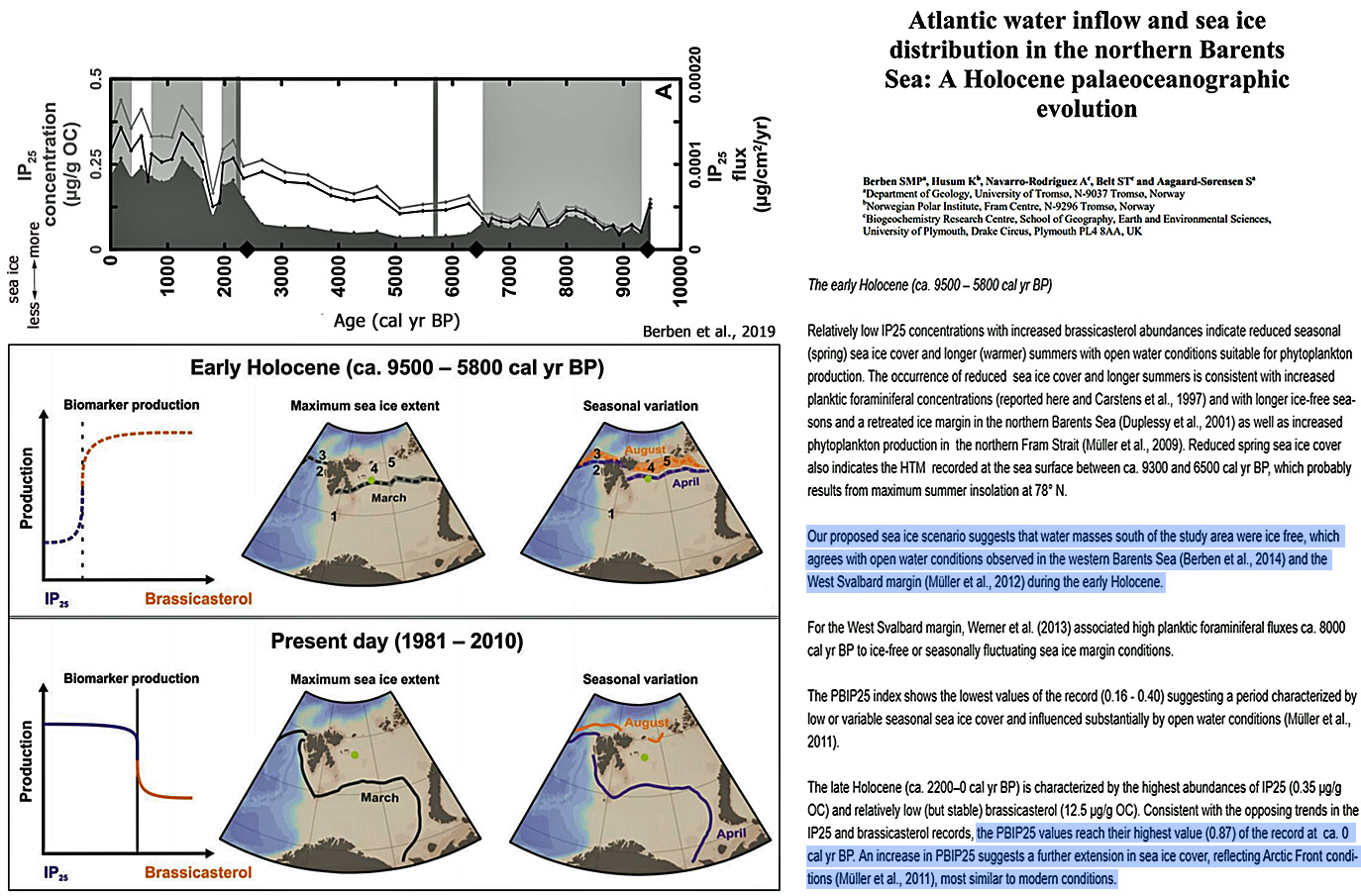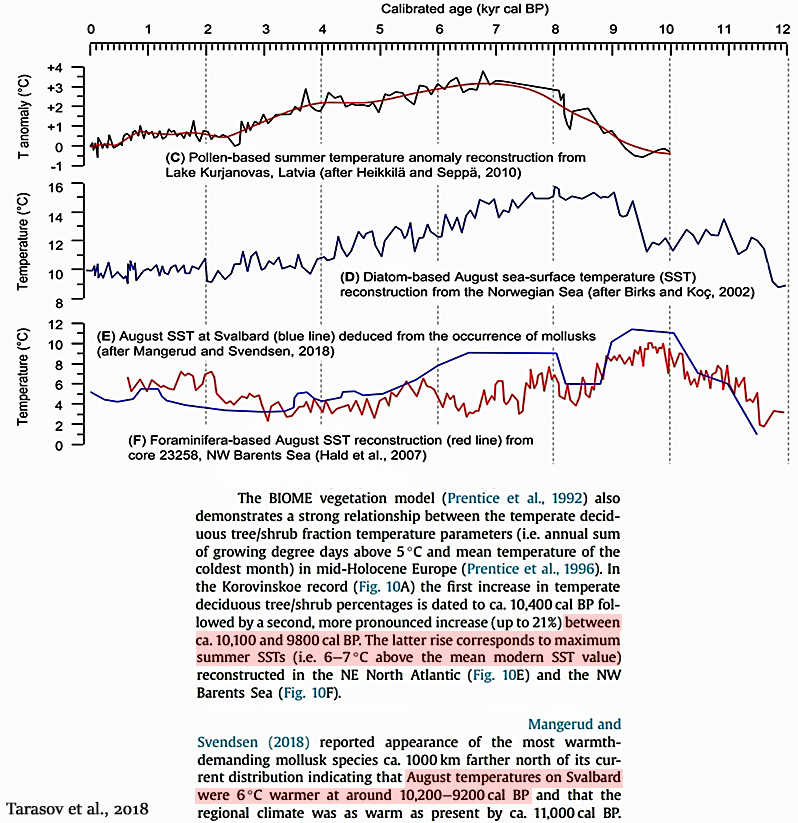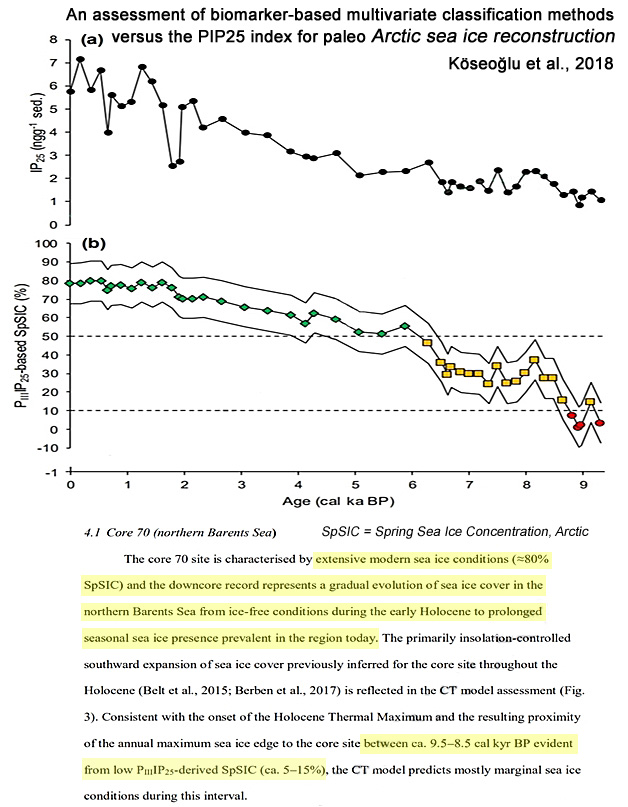By Kenneth Richard on 23. May 2019
Biomarker evidence for Arctic-region sea ice coverage in the northern Barents Sea indicates the most extensive sea ice conditions of the last 9,500 years occurred during the 20th century (0 cal yr BP). In contrast, this region was ice free with open water conditions during the Early Holocene (9,500-5,800 years ago).

Atlantic water inflow & sea ice distribution in the northern
Barents Sea: A Holocene palaeoceanographic evolution
“The early Holocene (ca. 9500 – 5800 cal yr BP) … Relatively low IP25 concentrations [a proxy for sea ice presence] with increased brassicasterol abundances indicate reduced seasonal (spring) sea ice cover and longer (warmer) summers with open water conditions suitable for phytoplankton production. The occurrence of reduced sea ice cover and longer summers is consistent with increased planktic foraminiferal concentrations (reported here and Carstens et al., 1997) and with longer ice-free seasons and a retreated ice margin in the northern Barents Sea (Duplessy et al., 2001) as well as increased phytoplankton production in the northern Fram Strait (Müller et al., 2009). Reduced spring sea ice cover also indicates the HTM recorded at the sea surface between ca. 9300 and 6500 cal yr BP, which probably results from maximum summer insolation at 78° N.”
“Our proposed sea ice scenario suggests that water masses south of the study area were ice free, which agrees with open water conditions observed in the western Barents Sea (Berben et al., 2014) and the West Svalbard margin (Müller et al., 2012) during the early Holocene.”
“For the West Svalbard margin, Werner et al. (2013) associated high planktic foraminiferal fluxes ca. 8000 cal yr BP to ice-free or seasonally fluctuating sea ice margin conditions.”
“The PBIP25 index shows the lowest values of the record (0.16 – 0.40) suggesting a period characterized by low or variable seasonal sea ice cover and influenced substantially by open water conditions (Müller et al., 2011).”
“The late Holocene (ca. 2200 – 0 cal yr BP) is characterized by the highest abundances of IP25 (0.35 µg/g OC) and relatively low (but stable) brassicasterol (12.5 µg/g OC) (Figure 7A-B).). Consistent with the opposing trends in the IP25 and brassicasterol records, the PBIP25 values reach their highest value (0.87) of the record at ca. 0 cal yr BP. An increase in PBIP25 suggests a further extension in sea ice cover, reflecting Arctic Front conditions (Müller et al., 2011), most similar to modern conditions.”
The Early Holocene was about 6-7°C warmer than today in this region (NW Barents Sea).

Another recent reconstruction for this region also indicated the Early Holocene was sea ice free and that modern sea ice conditions are among the most extensive of the last 9,500 years.

Posted in Arctic, Paleo-climatology, Sea Ice |








[…] Read more at No Tricks Zone […]
Fresh water from the melted ice cap at the end of the last ice age poured into the Atlantic and changed the AMO. The Laurentide Ice Sheet was no more except for what’s left of it on Baffin Island.
Takes 20,000 years of climate change to make it happen like it is here today for the 21st schizoid man to survive it all. The Milankovitch Cycle at work, apparently.
https://stopthesethings.com/
http://euanmearns.com/
https://notalotofpeopleknowthat.wordpress.com/
Good reading at those websites and Wattsupwiththat, of course.
Asparagus shoots finally appeared on May 21st, later than normal. In the early nineties, May 5th to May 8th were the earliest times when asparagus was picked.
The biomarker for the beginning of the warming of springtime temps.
Picked a good eight asparagus shoots, always on the lookout for fresh asparagus hither and yon in the stretches of where it dwells.
Later than normal for asparagus picking for the last ten years or so.
A little more rain, more asparagus until the middle of June, then it’s over.
When the apple trees are in bloom, you can plant it all. The birds sing for a reason.
The geese are leading their goslings, lots going on and on the move as summer gets here fast.
[…] K. Richard, May 23, 2019 in […]
Tony Heller has a good related post, here.
https://realclimatescience.com/2019/05/ice-doesnt-lie-but-climate-scientists-do/
[…] https://notrickszone.com/2019/05/23/new-paper-arctic-sea-ice-was-far-less-extensive-than-today-durin… […]
[…] New Paper: Arctic Sea Ice Was Far Less Extensive Than Today During The ‘Ice Free’ Early … […]